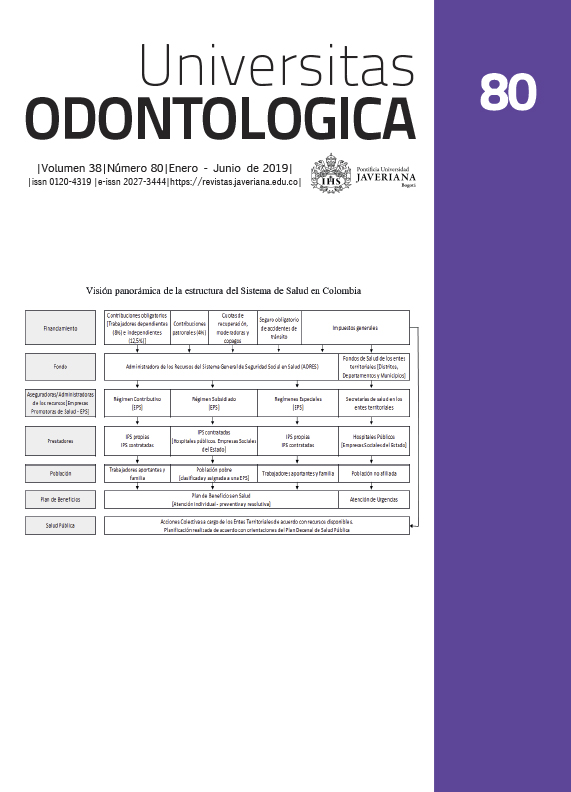Abstract
Background: The staff of the health area is constantly exposed to blood and / or fluids coming from patients during their workday. Therefore, dentistry personnel run the risk of contracting infectious diseases. Purpose: To know the frequency of occupational risk due to sharp objects in top-level dentists of the urban and rural Health Centers of the Health Services of Nuevo León. Methods: design of the non-experimental, descriptive, cross-sectional and prospective study. Study population: applicative dentists of the Health Services of Nuevo Leon with a probabilistic sampling 108 of dentists. A questionnaire designed with 12 questions related to sharps accidents with a reliability of a Cronbach's alpha of .832 was used. Results: 38.8 % of the men reported having presented an accident at work and 67.2 % of the women reported having suffered an accident with a sharp cut. In relation to knowing if they had suffered an infection due to an accident by sharp objects, 59.3 % had suffered an accident and 40.7 % had not suffered an accident; 49 % were trained in biosecurity and 51 % have not received training. Conclusion: Based on these results we can conclude that there is still a need to improve the training and expand the coverage of training to the dentist in matters of biosafety regulations and management of infectious biological dangerous wastes as well as to update the knowledge of puncture-borne infections.
2. Rodríguez Y, Rivero M, Solana L, Pérez K. Nivel de conocimientos y actitud ante el cumplimiento de la bioseguridad en estomatólogos. Revista de Ciencias Médicas. 2012; 18(1).
3. Centro Nacional para la Prevención y el Control del VIH y el SIDA (CENSIDA). Guía para la atención estomatológica en personas con VIH. Consejo Nacional de Programas Preventivos y Control de Enfermedades. México DF, México: CENSIDA; 2015.
4. Junco R, Oliva S, Barroso I, Guanche H. Riesgo ocupacional por exposición a objetos punzocortantes en trabajadores de la salud. Rev Cub Hig Epidemiol. 2003; 41(1).
5. Collins CH, Kennedy DA. Microbiological hazards of occupational needle stick and ¨sharps¨ injuries: a review. J Appl Bacteriol. 1987; May 62(5): 385-402.
6. Adegbaye AA, Moss EB, Soyinka F, Kreiss JK. The epidemiology of needle stick and sharp instrument accidents in a Nigerian hospital. Infect Control Hosp Epidemiol. 1994; 15(1): 27-31.
7. Organización Mundial de la Salud (OMS). VIH/SIDA. Ginebra, Suiza: OMS; 2018. Descargado el día 06/03/2018. Disponible en: http://www.who.int/hiv/es
8. Organización Mundial de la Salud (OMS). Hepatitis B. Ginebra, Suiza: OMS; 2018. Descargado el día 06/03/2018. Disponible en: http://www.who.int/mediacentre/factsheets/fs204/es
9. Ruiz, A. R., Fernández, J. R., Principios de Bioseguridad en los servicios estomatológicos. Rev Cient Villa Clara. 2013; 17(2): 49-55.
10. Cázares F, Alveza, M, Pinedo M. Estrés percibido en odontólogos de los Servicios de Salud de Nuevo León. Rev Mex Estomatol. 2017; 4(2): 16-26.
11. Gutiérrez C, Alarcón J, Sánchez S, Carrión M. Prevalencia y factores asociados a heridas punzo-cortantes en trabajadores de salud del primer nivel de atención. Revista Peruana de Epidemiología. 2008; 12(2): 1-9.
12. Barroso AJ, Camacho MA, Cashat CM, Cornu GL. Accidente con material punzocortante en trabajadores de la salud. Una situación digna de ser revisada. Enfermedades Infecciosas y Microbiología. 2006; 26(1).
This journal is registered under a Creative Commons Attribution 4.0 International Public License. Thus, this work may be reproduced, distributed, and publicly shared in digital format, as long as the names of the authors and Pontificia Universidad Javeriana are acknowledged. Others are allowed to quote, adapt, transform, auto-archive, republish, and create based on this material, for any purpose (even commercial ones), provided the authorship is duly acknowledged, a link to the original work is provided, and it is specified if changes have been made. Pontificia Universidad Javeriana does not hold the rights of published works and the authors are solely responsible for the contents of their works; they keep the moral, intellectual, privacy, and publicity rights.
Approving the intervention of the work (review, copy-editing, translation, layout) and the following outreach, are granted through an use license and not through an assignment of rights. This means the journal and Pontificia Universidad Javeriana cannot be held responsible for any ethical malpractice by the authors. As a consequence of the protection granted by the use license, the journal is not required to publish recantations or modify information already published, unless the errata stems from the editorial management process. Publishing contents in this journal does not generate royalties for contributors.



